Home | Front Page | Blog | Index | New | Contact | Site Map
Cuarenta Casas
Paquime
La Quemada
Teotenango
Xochicalco
Chalcatzingo
Cacaxtla
Monte Alban
Mitla
Palenque
Uxmal
Chichen Itza
Tolum
Belize Mayans
Tikal
Guatemal Mayans
Copan
Mexico 2003:
PtI |
PtII |
PtIII
States |
Websites |
Map
Churches
Car Costs
Swimming Along
Beach Bumming
El Altiplano
Ancient Sites
Coahuila
Chihuahua
Durango
Jalisco
NuevoLeon
Sinaloa
Sonora
Zacatecas
USA 2003
USA 2002
Britain 2002
There are a vast number of Mayan and non-Mayan pre-Columbian cities and religious centers in Mexico and northwest Central America. In 2003 from Northwest Mexico to the Yucatan we saw nearly a dozen non-Mayan sites, about half of them major. As it happened not long after the change of the year to 2004 we entered the Mexican Yucatan and then went on to Belize, Guatemala, and Honduras where we saw another dozen sites, all of these Mayan. We've made web pages for all of the major sites that we visited, mostly listed at left. "Major" means that there are more than one or two buildings or temples and a proper visit takes more than an hour. A few of the sites are treated as part of the page of the city or area nearby.
We haven't seen all the sites, major or minor, though it wasn't for lack of trying by Gerry. But we started to run out of time and when the going got hot and heavy Jan just could not keep up her interest. So after being fairly thorough in north and west Mexico, by the time we got to south and west Mexico we both skipped many sites and spent more time on hotel balonies and in beach chairs, read more newspapers, and saw lots more of CNN and BBC World.
Our first two settlements were Cuarenta Casas and Paquime, both in Chihuahua State, We saw these during late April as we made a swing through Mexico from Texas to Arizona, testing the waters for our longer trip. In August we came back to Mexico and travelled south along a westerly route before heading north again through Guadalajara to Zacatecas. There we saw our first major non-Mayan site: La Quemada near Zacatecas.
After Zacatecas we returned to the US for month, which we spent in McAllen,Texas, and then headed south for a three week swing through Mexico's Altiplano and a half dozen beautiful colonial cities. Our visits to pre-columbian sites started again in the area west of Mexico City where our site visits got so hot and heavy that we saw almost one a day.
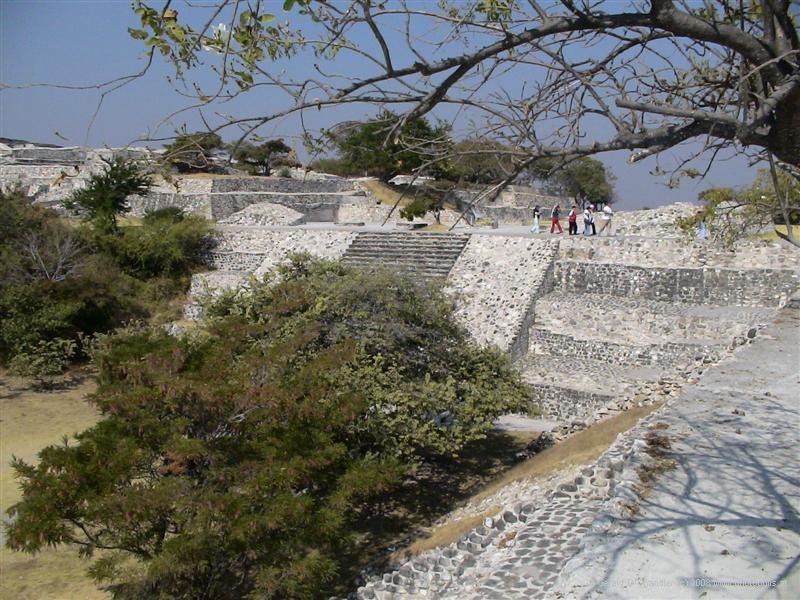
Xochicalgo Pyramid and Plaza |
In mid December in and around Patzcuaro. we saw three sites: X, Y, and Z. And then with hardly a break we north of Toluca. we saw Calixtla. and south we saw the much more impressive Teotenango.
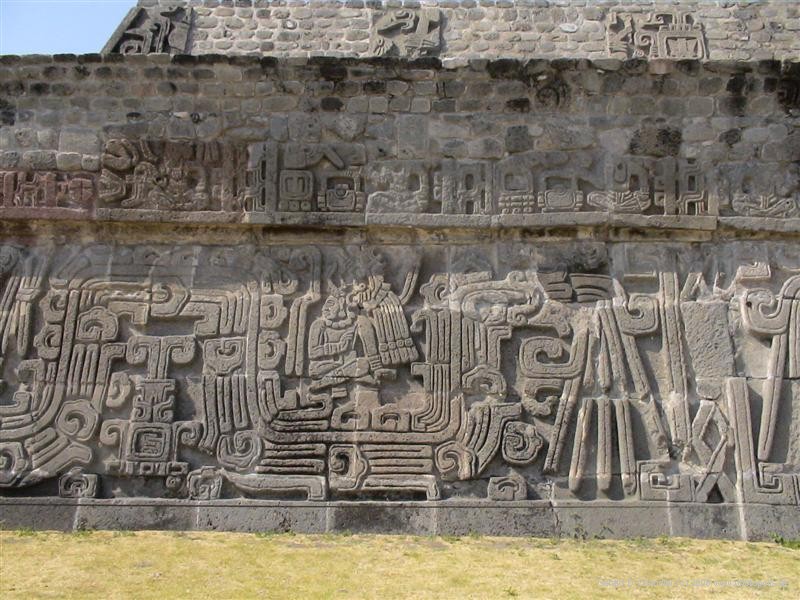
Hieroglypic message at Xochicalgo |
Going on in late December, on our way to Cuernavaca we saw Xochicalco which almost blew our minds away, it was so unexpectedly big. In Cuernevaca Gerry, on an evening walk by himself, saw a much smaller temple, XX, that was to Xochicalco like a parish church is to Westminster Abbey.
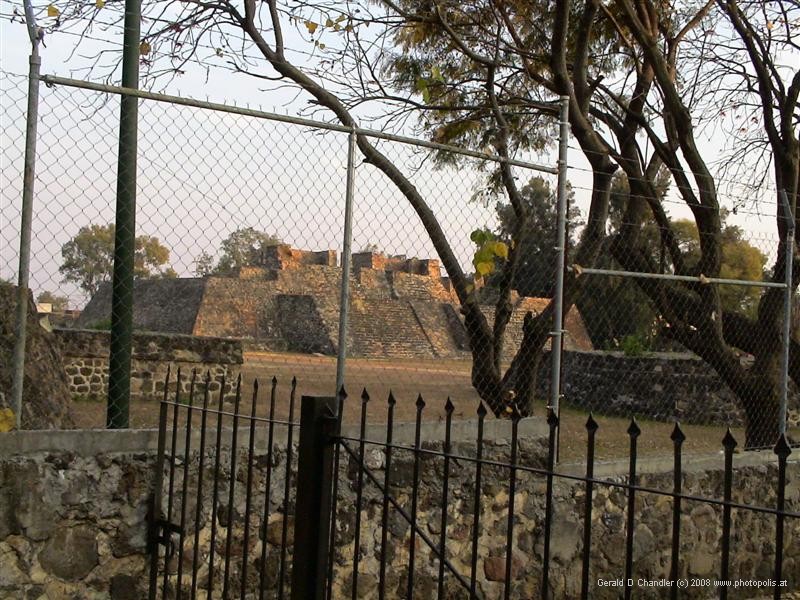
Cuernavaca's Pre-Columbian Temple |
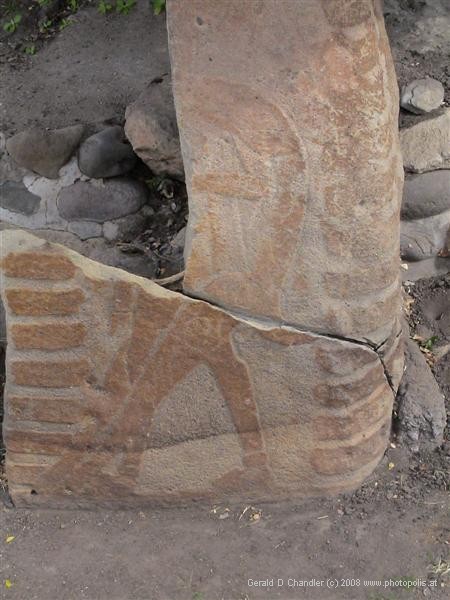
Chalcatzingo |

Pastel Mural at Cacaxtla |
On our drive to Puebla we saw Chalcatzingo and then north of Puebla in Tlatlaca we saw the twin sites of Cacaxtla and Xochitecatl.
In and around what is now Oaxaca City was once Zacatec territory. We saw their great city of Monte Alban and the lesser city of Mitla. While small, Mixta was impressive for the lattice work decorations of its buildings. Unfortunately we didn't feel we had the time (translation: energy) to see WW.The great, great Aztec site is Teotihuacan, which we visited in 1978 and did not visit this trip. The Aztecs had been an oppressed people just two hundred years before the arrival of the Spanish conquistadors. But about 1300 the power of their masters started to wane and they grew, conquering their former masters and then the territories farther and farther from their base in the central Mexican highlands. As they grew in power their beliefs and architecture spread by conquest or by radiating influence.
The Mayan sites, collectively much more famous, are located in the Yucatan and adjacent areas south and east. This includes parts of Mexico, Guatemala, and Honduras. We saw them mid-January through mid-March, 2004

Territories of Mayan Culture in Mexico and South
|
When we planned our travels we had heard of two of the four or five great Mayan sites: Palenque and Chichen Itza. In fact it was the description of Palenque in a used copy of "Let's Go Mexico" that convinced first Gerry and then Jan that southern Mexico had some things worth going a long way to see. From "Let's Go" we learned that two other sites equalling them existed outside Mexico: Tikal in Guatemala and Copan in Honduras, but the descriptions were brief.
Our ignorance was great. As the map shows there are many more sites. Of those shown, we eventually visited Uxmal and Tolum in Mexico and Quirigua in Guatemala. Mayan sites that we visited which are not on the map are Tohcok (so small admission is not charged) and Copal in Mexico, four sites in Belize (Lamanai, Cahal Pech, Xunantunich), Ceibal in Guatemala (which we reached by boat), and El Puente (near La Entrada) Honduras.
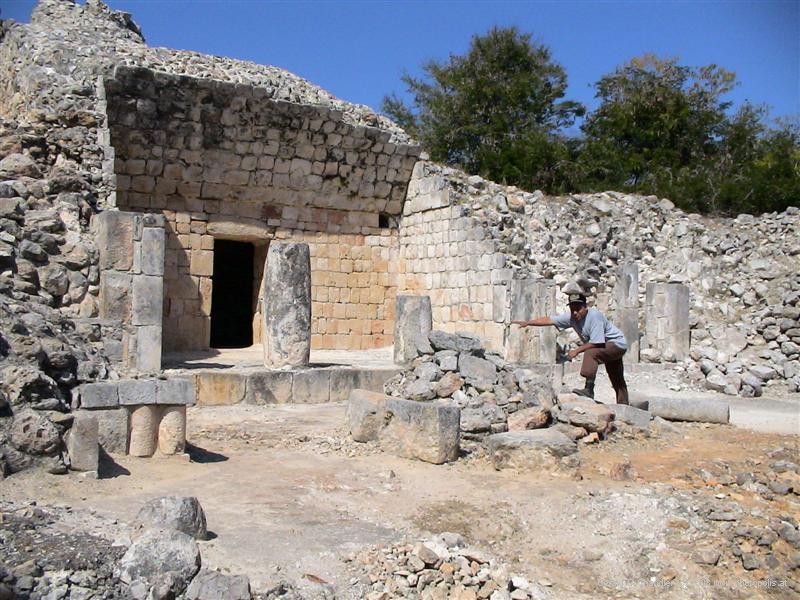
Major part of Tohcok Ruin, Campeche, Mexico |

El Puente Mayan site, Honduras |
It is interesting to note how short a time we have known much about the ancient world. It wasn't until the 1820s that Jean-François Champollion completed the decipherment that Thomas Young had started of the Roseta Stone and archeologists and then we, the general public, began to really know what the great Egyptian temples were all about. It was even later, a full century later, that the big picture of the peoples of ancient Mesoamerica began to become clear. Before the 1940s the pictures of the Meso american world was not qualitatively different than that Hernan Cortes and other Spanish conquisitors had. But after 1940 many new temples were found and excavated. Progess equivalent to deciphering the Rosetta Stone was made and a nearly complete understanding of incriptions on ancient mesoamerican temples and stellae was achieved.
From this it was realized that a great ancient culture had existed, developing from 1000 BC onward. It was given the name Olmec. From it all of the other great cultures of the area derived their basic ideas about the universe, their religious practices, their calendar, and their means of religious expression.
